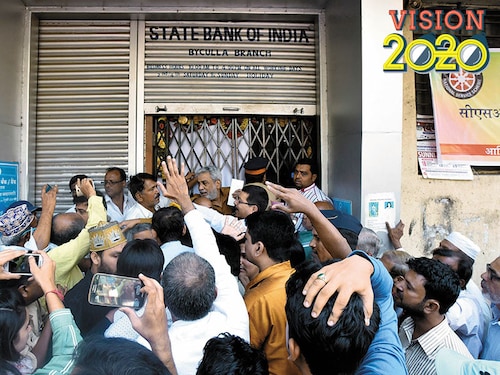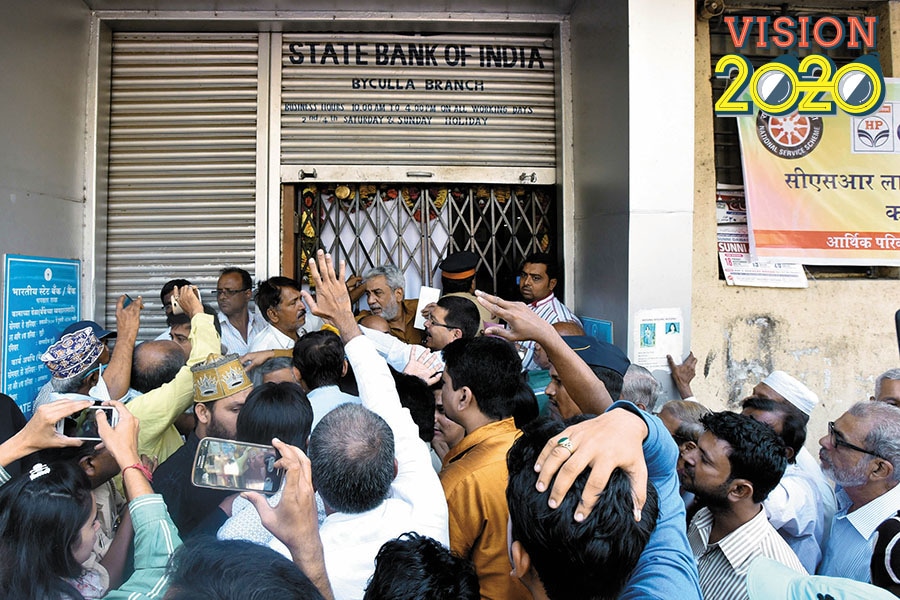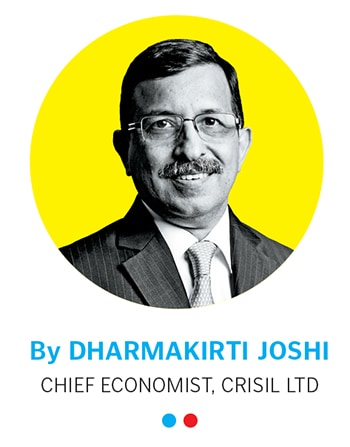Three economic lessons India learnt in the 2010s
India's economic ride over the past decade underlines the importance of raising the potential growth rate, writes CRISIL's Dharmakirti Joshi


 Account holders thronged banks to deposit invalid currency notes following demonetisation in 2016
Account holders thronged banks to deposit invalid currency notes following demonetisation in 2016
Image: Kunal Patil / Hindustan Times via Getty Images[br]There are two ways of looking at India’s waning growth.
A counter-cyclical stimulus, however, needs to be exercised with caution. Fiscal and monetary policies can’t be stretched too thin, for then the economy becomes vulnerable, as inflation and other macro distortions creep in. The government, thus, has little choice but to go hard at reforms, gradually stimulate demand and generate employment.
A flashback of the past decade would be in order here. At over 7.1 percent per year average, India grew at its fastest pace ever between FY10 and FY19.
But the tyranny of averages is such that it masks volatility in data. The decade also saw two downturns—one is ongoing, and the other was in FY12. Strong monetary and fiscal stimuli, after the 2008 financial crisis, meant growth could rebound to 8.5 percent in FY10 from 3.1 percent in FY09, but that was flattering to deceive.
There were three lessons learnt in this journey. The first was that any steroidal push out of a crisis is ephemeral. It creates macroeconomic distortions if not accompanied by structural changes that raise an economy’s potential growth rate. The stimuli led to double-digit, generalised inflation, a surge in fiscal deficit to 5.9 percent of GDP, and a spike in current account deficit to 4.2 percent of GDP—all way above prudent limits—in FY12.
The inevitable downturn…
By FY12, GDP growth had slipped to 5.2 percent. Many scandals rocked the business world, decision-making was impaired, and the stimuli had to be pulled back to fight the raging price and deficit fires. Adding fuel was high crude prices (Brent averaged over $100 per barrel in the three years through FY14).
The upshot? Rapidly decelerating growth. Also, aggressive investments during the rebound from the global financial crisis, and wanton lending by banks led to overcapacity (which continues even today in some segments). That spree created humongous non-performing assets at banks as the economy hard-braked.
The second lesson learnt was that domestic fragility makes a country more vulnerable to external shocks. For example, those running current account deficits get punished disproportionately in a global risk-off.
Manufacturing will account for over 20% of GDP: M&M Group chief economist
The ‘taper tantrum’ was one such occasion when the US Fed’s talk of ending quantitative easing sent the rupee into a tailspin and caused massive emerging market outflows. Soon, India was bracketed along with Brazil, South Africa, Indonesia, and Turkey as the ‘Fragile Five’ economies of the world.
But things started to look up from FY14: Aided by a fortuitous plunge in crude oil prices, GDP growth touched 8.2 percent in FY17 and macro fundamentals (inflation and the twin deficits) improved.
…and the redux
But then came the disruptions of demonetisation, the Goods and Services Tax (GST), the banking sector clean-up, and rising global uncertainty stemming from trade disputes.
The ensuing weak global growth, falling trade intensity and poor competitiveness crunched India’s exports. If that wasn’t enough, a gradual pick-up in crude oil prices also caused angst.
The GST rollout had a knock-on effect on exports growth in FY18 because of delay in refunds to exporters. Simultaneously, the farm front continued to flounder, with terms of trade deteriorating in FY18 and FY19, and weak wage growth further affecting rural incomes.
In all that time, public sector banking remained incapacitated because efforts to improve transparency and credit culture led to rising bad loans. The onset of the non-bank (non-banking finance companies + housing finance companies) crisis in September 2018 aggravated the situation. Given that non-bank penetration is high in certain household consumption segments, the stress hard-braked demand.
The third lesson learnt between 2014 and now is that large-scale reforms have an economic cost, at least in the short term.
Straying from the plot
In FY19, GDP growth dropped to 6.8 percent and this fiscal is set to see an even sharper fall. Weakness in the real estate sector and stress in the financial sector have been feeding off each other and pulling growth down.
The ongoing clean-up of the financial sector could stretch the slowdown, particularly when the policy space to fire the economy in the short run is limited.
When GDP growth plunged to 5 percent in FY20 Q1, it prompted the government to take action and boost sentiment. Corporate tax cuts, and measures for the real estate and automobile sectors were announced.
While these are medium-term positives, they may not stoke growth in the near term. Recent surveys by the Reserve Bank of India (RBI) show a precipitous drop in business and consumer sentiment. It’s no surprise that GDP growth in Q2 was a 26-quarter low of 4.5 percent.
"Education needs a revolution in the 2020s": Byju Raveendran
Between a rock and a hard place
Indeed, policymakers are caught between a rock and a hard place. With revenues way behind targets—growth in both direct and indirect taxes has been anaemic so far—the government has its task cut out with the fiscal deficit target at a tight 3.3 percent of GDP for this fiscal. That means it could be a drag on growth, just like last fiscal.
Recent data offers some hope: Public spending seems to have improved. But that makes it imperative to fast-track non-tax revenue generation through divestments and asset monetisation to keep the fiscal deficit under check.
On the other hand, monetary policy is not having the desired impact. Despite a cumulative repo rate cut of 135 basis points by the RBI in 2019, banks have pared their lending rates only 40 to 50 basis points. The willingness to supply credit has also reduced because of risk aversion and weak sentiment.
The RBI’s pause during its December monetary policy review, and reduction in its India growth forecast, are understandable in the context.
Yoking growth back to the trendline
On balance, we expect the economy to grow at 5.1 percent in FY20, taking into account weak growth in the first half of this fiscal and mild recovery in the second.
That said, medium-term prospects for India still remain promising, and growth should hoist itself up to 6.5 to 7 percent over the medium run. How?
First, healthier corporate balance sheets and a stronger banking sector will underpin recovery. The evolving system will not only improve the ability of banks to recover debts, but also, for the first time, instil fear among promoters of losing their companies altogether.
Second, given the sweeping anti-globalisation sentiment, India will need to increasingly look inward to propel growth. The recent ‘efficiency enhancing’ reforms create room for this.
For example, the GST and the Insolvency & Bankruptcy Code are expected to improve the allocation and efficiency of capital, make the system efficient, and support growth, once streamlined.
Indeed, the current slowdown is a clarion call to go hard at reforms such as making labour laws flexible, land acquisition easier, and structurally improving the ease of doing business—with sharp focus on contract enforcement. This will help re-ignite the virtuous cycle of growth, savings and investment.
How the government deploys its political capital to do all that will determine how much the potential growth rate can improve.
First Published: Jan 15, 2020, 10:45
Subscribe Now